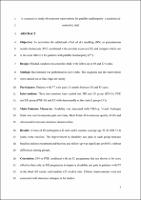Por favor, use este identificador para citar o enlazar este ítem:
https://repositorio.usj.es/handle/123456789/1094
| Título : | A Comparative Study of Treatment Interventions for Patellar Tendinopathy: A Randomized Controlled Trial (Versión aceptada) |
| Autor: | López-Royo, María Pilar


Ríos-Díaz, José 

Galán-Díaz, Rita María Herrero Gállego, Pablo 


Gómez-Trullén, Eva María 

|
| Palabras clave : | Patellar Tendinopathy; Tendinopathy; Percutaneous Needle Electrolysis; Dry Needling; Eccentric Exercise |
| Fecha de publicación: | 6-feb-2021 |
| Editorial : | Elsevier |
| Citación : | María Pilar López-Royo, José Ríos-Díaz, Rita María Galán-Díaz, Pablo Herrero, Eva María Gómez-Trullén, A Comparative Study of Treatment Interventions for Patellar Tendinopathy: A Randomized Controlled Trial, Archives of Physical Medicine and Rehabilitation, Volume 102, Issue 5, 2021, Pages 967-975, ISSN 0003-9993, https://doi.org/10.1016/j.apmr.2021.01.073 |
| Resumen : | Objectives To determine the additional effect of dry needling (DN) or percutaneous needle electrolysis (PNE) combined with eccentric exercise (EE) and determine which is the most effective for patients with patellar tendinopathy (PT). Design Blinded, randomized controlled trial, with follow-up at 10 and 22 weeks. Settings Recruitment was performed in sport clubs. Diagnosis and intervention were conducted at San Jorge University. Participants Patients (N=48) with PT with pain for at least 3 months between the ages of 18 and 45 years. Interventions Three interventions were carried out: DN and EE, PNE and EE, and EE with sham needle as the control group. Main Outcome Measures Disability was measured using the Victorian Institute of Sports Assessment Questionnaire, patellar tendon. Visual analog scale was used to measure pain over time, the Short Form-36 was used to measure quality of life, and ultrasound was used to measure structural abnormalities. Results A total of 48 participants (42 men, 6 women; average age, 32.46y; SD, 7.14y) were enrolled. The improvement in disability and pain in each group between baseline and post-treatment and baseline and follow-up was significant (P≤.05), without differences among groups. Conclusion DN or PNE combined with an EE program has not shown to be more effective than a program of only EE to improve disability and pain in patients with PT in the short (10wk) and medium (22wk) terms. Clinical improvements were not associated with structural changes in the tendon. |
| URI : | https://repositorio.usj.es/handle/123456789/1094 |
| ISSN : | 0003-9993 |
| Aparece en las colecciones: | Artículos de revistas |
Ficheros en este ítem:
| Fichero | Descripción | Tamaño | Formato | |
|---|---|---|---|---|
| A comparative study version aceptada.pdf | 336,67 kB | Adobe PDF |  Visualizar/Abrir |
Este ítem está sujeto a una licencia Creative Commons Licencia Creative Commons

